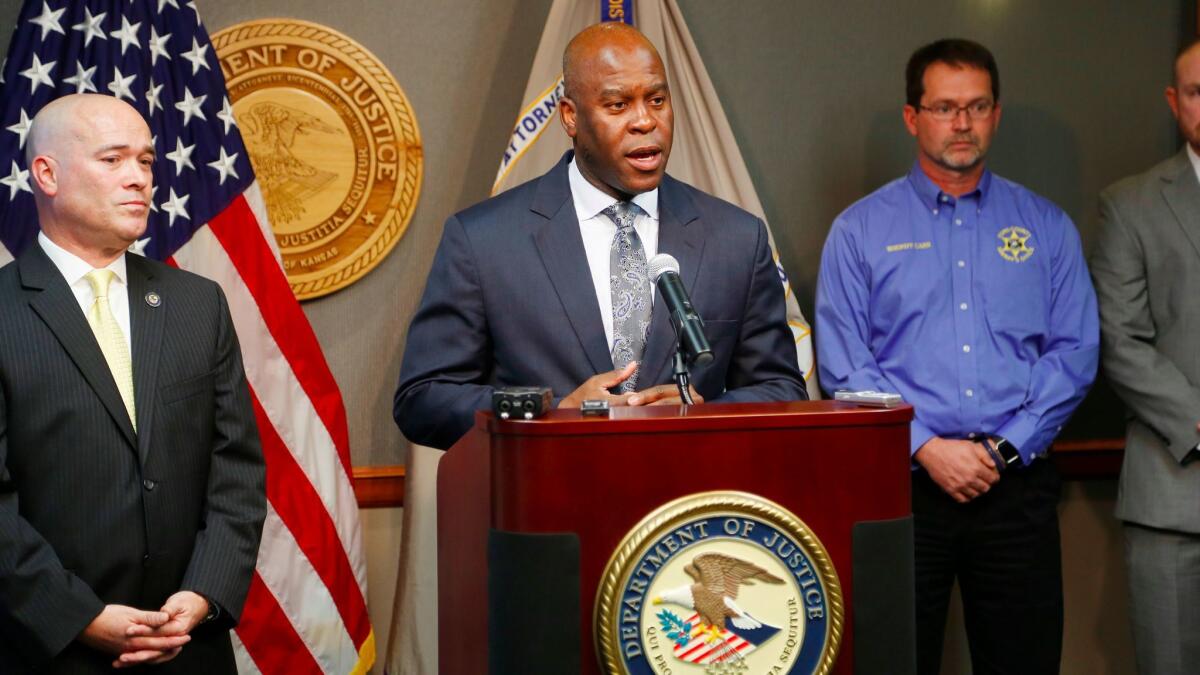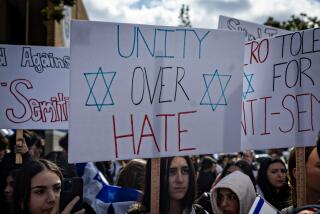Anti-Muslim incidents rose 57% last year, according to a new report

- Share via
The number of anti-Muslim incidents and crimes in the U.S. surged last year to some of the highest levels seen in recent times, according to a new report from a prominent Muslim civil rights organization.
The report by the Council on American-Islamic Relations documented a 57% increase in anti-Muslim incidents last year compared with 2015.
The victims included mosques set on fire, women whose hijabs were pulled off while walking down the street, Muslim groups that received threatening letters and Muslims who were denied jobs or promotions because of their faith or were “inappropriately targeted” for questioning by the FBI or other government agencies, the report said.
To produce the report, released Tuesday, CAIR investigated thousands of calls and emails made to dozens of its offices around the U.S. and reviewed data from national and local media reports. The process included interviews with witnesses and police.
Not all the incidents were reported to police or documented as crimes by law enforcement. CAIR said its report is a “mere snapshot of the experiences of the American Muslim community.” Officials suggested the report offered a more accurate picture than police data because anti-Muslim crimes are “vastly underreported to both law enforcement and community institutions.”
“It is time for the Trump administration to seriously address the growing anti-minority sentiment in our nation,” said Corey Saylor, who co-wrote the report and is the director of CAIR’s Department to Monitor and Combat Islamophobia.
Saylor said the rise was “prompted at least in part” by President Trump during last year’s campaign, including his promise to ban Muslim travel into the U.S. and his declaration that “Islam hates us.” Saylor also cited the president’s “toxic campaign rhetoric, the appointment of Islamophobes to policymaking posts and the introduction of Islamophobic policies such as the ‘Muslim ban.’”
Here are some of CAIR’s top findings.
There were 2,213 anti-Muslim incidents last year
Out of 4,282 “potential bias” cases reported to CAIR last year, the group found 52% of them to have an “identifiable element of religious, ethnic or national origin bias.”
CAIR broke down the incidents into five categories, with harassment being the most common. It made up 18% of events.
“Inappropriate” questioning or “targeting” by the FBI was second most common and accounted for 15% of cases. It was followed by employment-discrimination-related issues (13%) and hate crimes (12%).
Last was “denial of religious accommodation,” including women being told they couldn’t wear hijabs at work or people denied Korans while in jail or prison.
Saylor said reports made to CAIR have steadily increased over the years. In 2015, Muslims reported 3,786 incidents to the group. CAIR found 37% of those were targeted against the Islamic faith. The year prior, CAIR determined that just under 40% of the 3,359 reports it received were about anti-Muslim incidents.

Muslims were victims of 260 hate crimes last year
Among the thousands of potentially anti-Muslim incidents, CAIR counted 260 of them as hate crimes.
Some were already designated by law enforcement as hate crimes. Others were deemed by CAIR attorneys to legally qualify as hate crimes.
A hate crime is a legal designation as determined by the FBI. CAIR counted 180 hate crimes in 2015, which was up from 38 in 2014.
Among those CAIR tracked last year:
- The January attack of a Bangladeshi American man in New York City by two teens who yelled, “ISIS, ISIS!” at him before punching him in his head and kicking him while he was on the ground.
- A February incident in which a man in Missouri yelled, “You Muslim? All of you should die!” and pointed a gun at a Muslim couple shopping for homes in his neighborhood.
- The October arrest of three militia members from a Kansas group called “the Crusaders” who were charged with planning to bomb a mosque and an apartment complex where Somalis lived.
Last fall, the FBI reported a 67% increase in hate crimes against Muslims in 2015 compared with the previous year. The FBI has not yet released its 2016 hate crime report.
A person’s ethnicity or national origin was the most common ‘trigger’ of hate
Nearly 35% of the anti-Muslim incidents last year happened after perpetrators noticed a person’s ethnicity or national origin and made a connection to Islam, according to CAIR.
The group said the second most common kind of “trigger” was a woman’s hijab, or head scarf. About 16% of incidents last year — 346 — targeted women with hijabs.
The next most frequent factor was a person having a Muslim-sounding name. Those kinds of incidents made up 8% of the crimes and harassment cataloged.
The targeting of mosques and other worship spaces accounted for 5% of anti-Muslim incidents.
Homes were the most common locations of anti-Muslim incidents
Residences were the top targets of anti-Muslim incidents last year. The group found homes to be the site of 385 of the events in its report.
Educational facilities were the second most common. They were the top locations for anti-Muslim incidents in 2015.
In 2015 and 2014, homes did not make the top five list of places for crimes and harassment against Muslims.
CAIR officials said their data on “triggers” — why people were targeted — and the location of incidents suggest that people prejudiced against Muslims are becoming more likely to direct their attacks against specific people.
Jaweed Kaleem is The Times’ national race and justice correspondent. Follow him on Twitter, Facebook and Instagram.
ALSO
Trump fires FBI chief James Comey, citing handling of Clinton email investigation
A composite sketch helped lead to arrest of the Serial Street Shooter, Phoenix police say
Amid allegations of child sexual abuse, Seattle mayor declines to seek a second term
More to Read
Sign up for Essential California
The most important California stories and recommendations in your inbox every morning.
You may occasionally receive promotional content from the Los Angeles Times.











